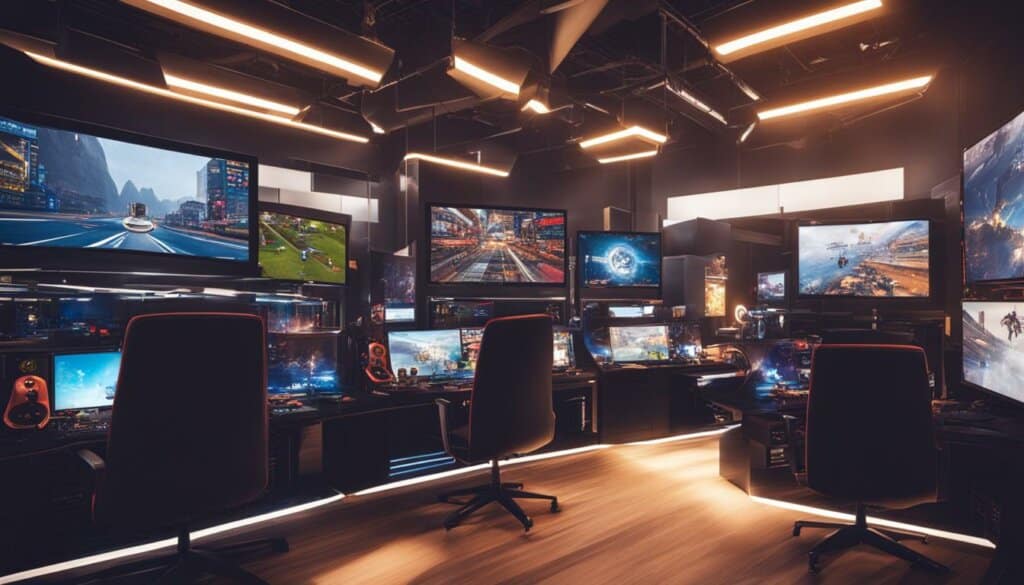Table of Contents
Gaming technology has a significant impact on various business applications, enhancing efficiency and profitability. Many programmers were inspired to enter the field of programming through video games. Although game development requires different skills and approaches compared to other forms of programming, understanding the differences can enable developers to transfer their existing skills to game development successfully.
Embracing game engines, such as Unity, and understanding concepts like movement, physics, the game loop, and frame rate can help developers create their own games effectively. Additionally, project setup in game development differs from traditional programming, and game developers often rely heavily on prefabs and component-based development. Embracing the multidisciplinary nature of game development, with programmers collaborating with designers, artists, and other disciplines, is crucial for successful game development projects.
Game development is not just about entertainment; it has found extensive applications in various industries. The growing popularity of gaming technology has led to its integration into business applications, resulting in increased efficiency and profitability. Whether it’s using virtual reality for employee training, gamification to enhance customer engagement, or leveraging data analytics to optimize processes, gaming tech has become an indispensable tool for businesses.
In this article, we will explore the relationship between gaming tech and business applications in more detail, highlighting the key ways in which gaming technology is driving innovation and improving efficiency in various industries. We will also delve into the specific skills and approaches required for successful game development and how these can be applied to enhance business applications.
Video Games Inspire Programmers in Business Applications
Many programmers were initially inspired by video games to pursue a career in coding. The experience of writing their own code for games sparked their interest in programming and the idea that they could control computers and make them do what they wanted. While these programmers may have started their careers working on business apps and non-game software, their desire to develop their own games often remained. However, transitioning from business programming to game development can be challenging, as there are significant differences in coding approaches, platforms, and languages.
Video games offer programmers a unique opportunity to express their creativity and unleash their coding skills. The interactive nature of games, coupled with the sense of achievement that comes from building a functional game, can be highly motivating. Aspiring game developers are drawn to the challenge of coding complex game mechanics, designing captivating gameplay experiences, and bringing their ideas to life.
In the world of business applications, programmers may focus on developing software that meets specific requirements or solves particular problems. However, game development offers a different kind of freedom and creativity. Programmers have the opportunity to create immersive worlds, develop engaging characters, and design challenging levels. This creative aspect, combined with the technical challenges of game development, provides a unique and rewarding experience for programmers.
“Video games were my first introduction to coding. I was fascinated by the idea of creating interactive experiences and challenging puzzles. It sparked my passion for programming and motivated me to pursue a career in game development. Although the transition from business applications to game development was challenging, it was worth it. Building games allows me to explore my creativity and create experiences that bring joy to players.”
| Video Game Inspiration | Business Application Development |
|---|---|
|
|
| Pros: | Pros: |
|
|
| Cons: | Cons: |
|
|
Transitioning from business applications to game development requires a willingness to learn new coding approaches and understand the unique concepts of game development. While there may be challenges along the way, the inspiration and passion that video games provide can drive programmers to overcome these obstacles and succeed in the world of game development.
Embracing the Differences in Game Development
Game development requires a different coding approach compared to other types of software development. While all programming is loosely related, understanding and embracing the differences in game development is key to success. Trying to code a game like a non-game software, such as a WPF app, can lead to challenges and increased risk of incomplete projects. It is important to learn the specificities of game development and avoid common pitfalls in order to build successful games.
In game development, developers need to shift their mindset and adapt to the unique requirements of gaming. Unlike traditional programming, game development involves creating interactive and visually engaging experiences for players. This requires a deep understanding of game mechanics, physics, and player interactions. Therefore, developers must be willing to learn new concepts and techniques that are specific to game development.
One common pitfall in game development is treating it like a WPF app or other non-game software. While the core principles of coding may seem similar, game development has its own set of rules and challenges. Ignoring these differences can result in inefficient code, poor performance, and frustrating user experiences. It is essential to embrace the differences and learn the best practices for game development in order to create high-quality games.
By understanding the specific requirements of game development and avoiding common pitfalls, developers can overcome the challenges and successfully build games that captivate and entertain players. Embracing the differences in coding approach, such as those related to movement, animation, and the game loop, is crucial for creating immersive and engaging gaming experiences. With a solid foundation in game development principles, developers can unlock their full potential and contribute to the thriving gaming industry.
| Differences in Game Development | Common Pitfalls | Best Practices |
|---|---|---|
| Unique coding approach | Treating game development like non-game software | Learn the specificities of game development |
| Focus on game mechanics and interactions | Ignoring the requirements of game development | Embrace the differences and adapt coding techniques |
| Creating immersive and visually engaging experiences | Using coding techniques from other domains | Understand game development principles and best practices |
The Importance of Embracing the Engine
When it comes to game development, embracing the game engine is of utmost importance. Instead of attempting to build a game from scratch, it is highly recommended to start with small projects using samples, guides, and video tutorials. By doing so, developers can gain valuable experience and learn the intricacies of the game engine.
Starting with small projects that can be completed in a day or two allows developers to familiarize themselves with the various features and functionalities of the engine. It’s similar to how a junior web developer would start by creating a simple sample page using a chosen framework before moving on to more complex projects.
Furthermore, building small games using samples and tutorials provides developers with a solid foundation and understanding of the game engine’s capabilities. This knowledge can then be applied to more ambitious game development projects. By embracing the engine and utilizing the available resources, developers can streamline their game development process and create high-quality games.
“Embracing the game engine is crucial when starting game development. Instead of immediately attempting to build a game from scratch, it is recommended to start with building small games using samples, guides, and video tutorials.” – Game Developer
| Advantages of Embracing the Engine | Disadvantages of Ignoring the Engine |
|---|---|
| Access to pre-built features and tools | Loss of time and effort in reinventing the wheel |
| Improved efficiency and productivity | Potential for coding errors and inconsistencies |
| Opportunity to learn from community resources | Limited understanding of engine-specific optimizations |
- Pre-built features and tools: The game engine provides a wide range of pre-built features and tools, such as physics engines, animation systems, and asset importers. Utilizing these resources can save developers significant time and effort.
- Improved efficiency and productivity: By leveraging the capabilities of the game engine, developers can focus on the unique aspects of their game without worrying about low-level coding tasks.
- Opportunity to learn from community resources: Game engines like Unity and Unreal Engine have vibrant communities with a wealth of tutorials, samples, and forums where developers can learn and exchange knowledge.
On the other hand, ignoring the game engine and attempting to build everything from scratch can lead to potential pitfalls. Developers may end up reinventing the wheel and wasting time and effort on tasks that the engine can handle efficiently. Moreover, ignoring the game engine means developers may miss out on the opportunity to learn from the community and take advantage of engine-specific optimizations.
Mastering Basic Movement and Animation
In game development, mastering basic movement and animation is crucial for creating immersive and visually appealing games. Many developers who are accustomed to coding movement via code may overlook the animation system provided by game engines. By utilizing the animation system, developers can create smooth and visually appealing animations in a fraction of the time it would take to hard code movements.
For example, in the popular game “Cut the Rope,” the adorable character Om Nom moves smoothly and interacts with objects in a physics-based environment. The game engine handles these physics interactions without requiring developers to write complex physics code. Understanding and utilizing the built-in animation and physics systems can streamline game development and allow developers to focus on creating engaging gameplay experiences.
“Animation can truly bring a game to life. It adds personality, fluidity, and responsiveness to characters and objects,” says game developer Sarah Matthews. “By mastering basic movement and animation techniques, developers can enhance the player’s experience and create games that captivate and entertain.”
Benefits of Mastering Basic Movement and Animation
- Create visually appealing animations in a fraction of the time
- Utilize the built-in animation system provided by game engines
- Streamline game development and focus on creating engaging gameplay experiences
- Add personality, fluidity, and responsiveness to characters and objects
By mastering basic movement and animation, developers can elevate their game development skills and create captivating games that leave a lasting impression on players.
| Game | Description |
|---|---|
| Cut the Rope | A physics-based puzzle game where players must cut ropes to feed candy to the adorable character Om Nom. The game features smooth movement and interactions with various physics objects. |
| Mario Kart | A racing game where players control Mario and other characters in go-karts. The game features fluid movement, responsive controls, and visually appealing animations. |
| Assassin’s Creed | An action-adventure game where players control assassins in historical settings. The game showcases realistic movement and animations that bring the characters and environments to life. |
Understanding the Game Loop
The game loop is a vital concept in game development. Unlike in traditional programming environments, where the loop is hidden, the game loop in game development is visible or nearly visible. It is the backbone of any game, responsible for updating the game state, handling user input, rendering graphics, and more. Understanding the game loop is crucial for building functional and immersive games.
In game development, the game loop typically consists of three main stages: updating, rendering, and handling input. During the update stage, the game logic is executed, including updating the positions of game objects, checking collisions, and applying physics. The rendering stage involves drawing the updated game state onto the screen, creating the visual representation of the game. Lastly, the input stage involves processing user input, such as keyboard or mouse actions, and responding accordingly.
H3: Methods in the Game Loop
Within the game loop, there are a variety of methods that are called at different times during gameplay. These methods serve specific purposes and contribute to the overall functionality of the game. Some commonly used methods include:
- Awake(): This method is called when the game object is initialized, allowing developers to set up initial values or references.
- Start(): This method is called once before the first frame update and is often used for initialization tasks.
- Update(): This method is called every frame and is where most of the game logic resides. It handles tasks such as updating the positions of objects, checking for collisions, and handling user input.
- FixedUpdate(): This method is called at fixed intervals, regardless of the frame rate. It is commonly used for physics-related calculations and updates.
- LateUpdate(): This method is called after the Update() method and is typically used for tasks that need to be executed after all updates have been processed, such as camera movement or object tracking.
“Understanding the different methods within the game loop is essential for creating functional and immersive games. Each method serves a specific purpose and contributes to the overall gameplay experience.”
In addition to these methods, game developers also need to consider collisions within the game loop. Collisions occur when two or more game objects interact with each other. They can be detected using collision detection algorithms, and appropriate actions can be taken based on the collision results. Properly handling collisions is crucial for creating realistic and engaging gameplay experiences.
| Game Loop Stage | Description |
|---|---|
| Updating | Executes the game logic, updates positions, applies physics, and checks for collisions. |
| Rendering | Draws the updated game state onto the screen, creating the visual representation of the game. |
| Input | Processes user input, such as keyboard or mouse actions, and responds accordingly. |
Considering Frame Rate in Game Development
Frame rate is a crucial aspect of game development, impacting both the user experience and the coding considerations. It refers to the number of frames or images that are displayed per second in a game. A higher frame rate results in smoother gameplay, while a lower frame rate can lead to lag and choppy visuals. It is essential for game developers to consider frame rate when designing and coding their games to ensure optimal performance.
The Update() method is commonly used for coding movement in games. This method is called every frame, allowing developers to update the positions and behaviors of game objects. However, since the frame rate can vary depending on the system and hardware, it is crucial to take frame rate into account when determining the speed and movement of objects in the game.
To achieve consistent movement across different frame rates, game developers can utilize the Time.deltaTime static float. This value represents the time in seconds it took to complete the last frame. By multiplying Time.deltaTime with the desired movement or speed values, developers can ensure that the movement remains consistent regardless of the frame rate.
Example:
“By using
Time.deltaTimein my game, I was able to create smooth and consistent movement for my characters. Regardless of the frame rate, the characters moved at the same speed, providing a better gaming experience for the players.”

By considering frame rate and utilizing Time.deltaTime, game developers can create games that deliver a seamless and enjoyable experience for players. It is important to ensure that the movement and speed of game objects remain consistent, regardless of the frame rate, to maintain gameplay integrity.
Project Setup in Game Development
When starting game development projects, it is crucial to understand the unique aspects of project setup in this field. Unlike traditional programming, game development relies heavily on folder structure and scene organization. The project’s folder structure allows for efficient management of assets, scripts, and other resources, ensuring a streamlined development process.
The main building blocks of a game project are scenes. Scenes act as the starting points for game setup and initialization. They allow developers to define the initial state of the game, set up game objects, and establish the flow of gameplay. By utilizing scenes effectively, developers can create modular and easily maintainable game projects.
Another important aspect of project setup in game development is code initialization. In traditional programming, code execution often starts with a centralized main method. However, in game development, code initialization is typically spread across different scripts and objects. Understanding how to manage code initialization through scene setup and object interactions is essential for creating cohesive and functional games.
| Project Setup in Game Development | Folder Structure | Scenes | Code Initialization |
|---|---|---|---|
| Involves organizing assets, scripts, and resources efficiently. | Allows for easy management and access to project files. | Act as the starting points for game setup and initialization. | Spread across different scripts and objects for a cohesive game experience. |
| Ensures a streamlined development process. | Simplifies asset and resource management. | Define initial game state and flow of gameplay. | Establishes code execution flow for different game elements. |
By mastering project setup in game development, developers can create well-structured and efficient games. Understanding the folder structure, utilizing scenes effectively, and managing code initialization are crucial steps in building successful game projects.
Dependencies and Injection in Game Development
In game development, managing dependencies is crucial for ensuring smooth and efficient development processes. Unlike in other software development fields, the use of dependency injection (DI) frameworks is less common in game development. Instead, game developers rely heavily on the concept of component-based development and the management of dependencies through the use of prefabs.
Component-based development is a key aspect of game development, where different game elements are created as self-contained components. These components can be easily reused and combined to create complex game objects. By utilizing prefabs, which are preconfigured game objects with attached components, developers can manage dependencies effectively without the need for a DI framework. Prefabs allow for easy replication and modification of game objects, simplifying the process of managing dependencies in game development projects.
While DI frameworks do exist for game engines like Unity, they are not widely used within the game development community. This is because DI frameworks often go against the principles of component-based development, which is the foundation of game development. However, it is important for game developers to understand the role of dependencies and injection in game development and be aware of the available DI frameworks if they choose to utilize them in their projects.
Overall, game development requires a unique approach to managing dependencies compared to other software development fields. By embracing component-based development and utilizing prefabs effectively, game developers can streamline the process of managing dependencies and create highly modular and scalable game projects.

| Dependency Management in Game Development | Dependency Injection in Other Software Development Fields |
|---|---|
| Relies on component-based development and the use of prefabs | Relies on DI frameworks to manage dependencies |
| Allows for easy replication and modification of game objects | Requires explicit configuration and injection of dependencies |
| Component-based development is the foundation of game development | DI frameworks are commonly used and promoted in other software development fields |
The Multidisciplinary Nature of Game Development
Game development is a highly multidisciplinary field that brings together professionals from various disciplines, including designers, artists, and programmers. Collaboration and effective communication between these different team members are vital for successful game development projects. Each discipline contributes unique skills and perspectives, combining their expertise to create immersive and visually appealing games.
Designers play a crucial role in game development, envisioning the overall game experience and creating the game mechanics. They focus on gameplay, level design, user interface, and user experience, ensuring that the game is engaging and enjoyable for players. Their creativity and understanding of player psychology are essential in shaping the game’s unique identity.
Artists bring the game to life through their visual talents. They create stunning graphics, captivating characters, and immersive environments that enhance the player’s experience. Their artistic skills and attention to detail add depth and realism to the game, making it visually appealing and compelling.
Programmers are the backbone of game development, responsible for bringing the designer’s vision to life. They work on coding the game’s features, implementing game mechanics, optimizing performance, and ensuring smooth gameplay. Their technical expertise and problem-solving skills are instrumental in building functional and engaging games.

The Role of Collaboration in Game Development
Collaboration is at the heart of successful game development projects. Designers, artists, and programmers must work closely together, constantly communicating and exchanging ideas to create the best possible game. Regular meetings and brainstorming sessions allow for the alignment of visions and the resolution of any conflicts or challenges that may arise.
“The beauty of game development lies in the seamless integration of different disciplines, each contributing their unique expertise. Collaboration is the key driver behind the creation of memorable and engaging games.” – Game Development Expert
By fostering a collaborative environment, game development teams can leverage their collective knowledge and skills to overcome obstacles and deliver high-quality games. The multidisciplinary nature of game development not only enriches the final product but also provides valuable learning opportunities for all team members, allowing them to expand their skill sets and grow professionally.
| Discipline | Role |
|---|---|
| Designers | Envision the overall game experience, create gameplay mechanics, focus on level design, user interface, and user experience. |
| Artists | Create stunning graphics, captivating characters, and immersive environments. |
| Programmers | Code game features, implement game mechanics, optimize performance, and ensure smooth gameplay. |
By understanding and embracing the multidisciplinary nature of game development, teams can unlock their full potential and create exceptional games that resonate with players.
Conclusion
Gaming technology has revolutionized various industries, bringing efficiency and profitability to business applications. The gaming industry continues to drive innovation, offering trends, hardware, software, and accessories that elevate gaming experiences. These advancements have a profound impact on business applications, paving the way for new possibilities.
Game development requires unique skills and approaches compared to other forms of programming. Embracing the game engine is crucial for aspiring developers, allowing them to leverage its power and functionality. Understanding the game loop, mastering movement and animation, and considering frame rate are essential for creating immersive and visually appealing games.
Project setup in game development differs significantly from traditional programming, emphasizing folder organization and scenes. Collaboration and communication between different disciplines, such as designers, artists, and programmers, are vital for successful game development projects. By embracing the multidisciplinary nature of game development, businesses can harness the full potential of gaming tech in their applications.
FAQ
How does gaming technology impact business applications?
Gaming technology enhances efficiency and profitability in various business applications.
How do video games inspire programmers in business applications?
Many programmers were initially inspired by video games to pursue a career in coding, which led them to develop their own games and apply their skills in business applications.
What are the differences between game development and other forms of programming?
Game development requires a different coding approach, platform, and language compared to other types of software development.
Why is it important to embrace the game engine in game development?
Embracing the game engine, such as Unity, allows developers to create games effectively and learn the nuances of game development through samples, guides, and tutorials.
How can developers master basic movement and animation in game development?
Developers can utilize the animation system provided by game engines to create smooth and visually appealing animations without writing complex code. Physics interactions can also be handled by the game engine.
What is the game loop in game development?
The game loop is a fundamental concept in game development that involves understanding the various methods called during gameplay, such as Awake(), Update(), and collision-related methods.
Why is frame rate important in game development?
Frame rate affects user experience and developers need to consider it when determining the speed and movement of objects in the game. Utilizing the Time.deltaTime static float helps ensure consistency across different frame rates.
How does project setup differ in game development?
Game development relies on folder organization and scenes as starting points for setup and initialization, rather than centralized code or main methods used in traditional programming.
What is the approach to managing dependencies in game development?
Game development focuses on component-based development, utilizing prefabs and the editor to manage dependencies. Dependency injection frameworks are less common in game development.
Why is collaboration important in game development?
Game development is a multidisciplinary field where collaboration between programmers, designers, artists, and other disciplines is essential for successful projects, leading to the creation of immersive and visually appealing games.
Source Links
- https://unity3d.college/2017/07/26/how-to-make-games-making-the-transition-from-business-apps-and-web-development-into-gaming/
- https://newsletter.pragmaticengineer.com/p/how-games-typically-get-built
- https://venturebeat.com/business/how-game-user-interfaces-can-inspire-better-tech-products/









